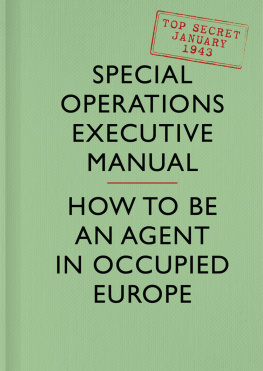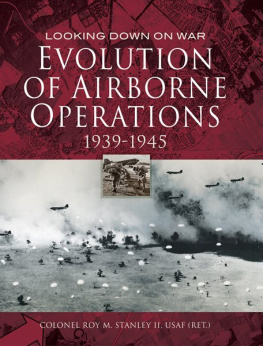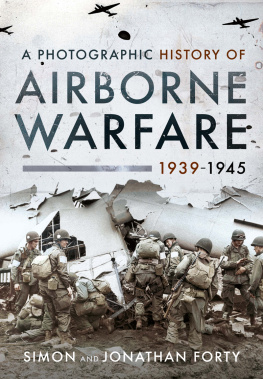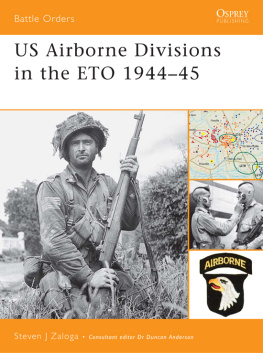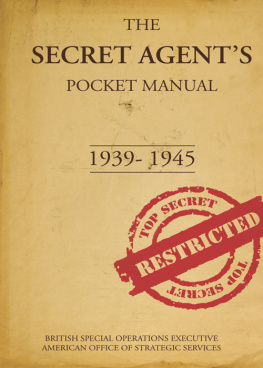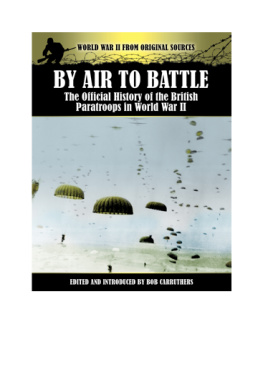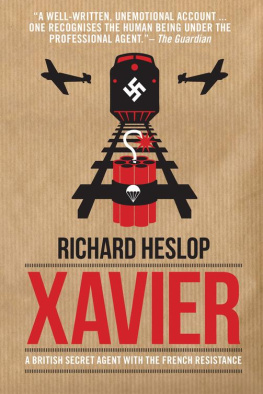
AIRBORNE
ESPIONAGE
INTERNATIONAL SPECIAL DUTIES
OPERATIONS
IN THE WORLD WARS
DAVID OLIVER

First published in the United Kingdom in 2005 by Sutton Publishing Limited
The History Press
The Mill, Brimscombe Port
Stroud, Gloucestershire, GL5 2QG
www.thehistorypress.co.uk
This ebook edition first published in 2013
All rights reserved
David Oliver, 2005, 2013
The right of David Oliver to be identified as the Author of this work has been asserted in accordance with the Copyrights, Designs and Patents Act 1988.
This ebook is copyright material and must not be copied, reproduced, transferred, distributed, leased, licensed or publicly performed or used in any way except as specifically permitted in writing by the publishers, as allowed under the terms and conditions under which it was purchased or as strictly permitted by applicable copyright law. Any unauthorised distribution or use of this text may be a direct infringement of the authors and publishers rights, and those responsible may be liable in law accordingly.
EPUB ISBN 978 0 7524 9552 1
Original typesetting by The History Press
Contents
Acknowledgements
Of the many people who assisted me in writing this book by providing personal anecdotes, I would like to extend particular thanks to the following individuals and organisations:
Franois Prins, who provided me with a constant stream of contacts and information; the late Bruce Robertson, who, as always, was a vital source of information he will be sadly missed; Sir Lewis Hodges, Reginald Lewis and Roy Buckingham, who flew with the RAF moon squadrons; Ron Clarke of the Carpetbagger Museum at Harrington; Ian Frimston, Cliff Knox, Richard Riding, Andy Thomas, Richard Chapman and Bo Widfeldts; Bill Strattons International Liaison Pilot and Aircraft Association; Peter D. Evanss Luftwaffe Experten Message Board; and the Royal Australian and Royal Norwegian Air Forces excellent archives.
Introduction
The twentieth century witnessed not only mans first flight in a heavier-than-air machine, but also the use of that machine as a powerful weapon of war. First as an airborne scout, then for dropping bombs on the enemy, it became a platform for shooting down enemy scout and bomber aeroplanes; and last but not least, and perhaps surprisingly, it became as a mode of transport for men and equipment.
There were plenty of opportunities for developing these roles in a century that will go down in history as witnessing the outbreak of no fewer than two world wars and countless local wars. These times of conflict and intrigue also brought an awareness of the value of another weapon intelligence: in particular what we now know as HUMINT (human intelligence) but which was previously known as spying.
At the start of the First World War, the transport by aeroplanes of spies across enemy lines was not seen as a priority by the combatants, but this would change as the conflict dragged on into its second year. At the beginning, there was no organisation for these flights, no reception teams at the drop zone and most importantly no communications network between the air forces and the agents, apart from homing pigeons or an occasional snatched telephone call.
The situation had not improved to any great extent by the outbreak of the Second World War in 1939. Although dedicated Special Duties air units had been established to fly the spies, or agents as they were then known, their aircraft were hand-me-downs and the role of their aircrews was considered a poor third to the more glamorous fighter and bomber operations.
However, the results ultimately achieved by these men and their aircraft were in many ways more hazardous and demanding than any other type of wartime flying. Finding a drop zone behind enemy lines at night, or actually landing in a remote field they had probably never seen before, with the only landing aids being the moonlight and a few hand torches, required a special type of expertise. Often flying an unarmed aircraft, and with the knowledge that being shot down and captured might end in summary execution, also called for a particular type of dedication and courage. Operating in all weathers, at low level and without escort, the Special Duties units paid a heavy price in aircrew killed and missing. By the very nature of these operations, their exploits were unreported during wartime, and for some considerable time thereafter; in fact, to this day, the official records of many of their flights have never seen the light of day and may never be released.
What is still relatively unknown is the fact that nearly all the Second World War combatants carried out clandestine flights to a greater or lesser extent. In the following chapters the exploits of British, Commonwealth, American, Free European, Soviet, German, Italian and Japanese airmen and units are recorded. The role played by the long-suffering ground crews who kept the Special Duties aircraft in the air, often in appalling conditions, must also be recognised as an integral part of the unsung backroom team which supported the individual agents and special forces who chose to operate in that most dangerous of wartime environments behind enemy lines.
CHAPTER 1
Behind the Lines
On a crisp moonlit night in the third winter of the Second World War, a dozen people took up their positions around a snow-dusted field in central France. Among them were local farm workers, a storekeeper, a pharmacist and a teacher. They had broken the six oclock curfew to risk local police and German checkpoints, travelling by foot, bicycle and delivery van to their windswept rendezvous. A few were armed with ancient shotguns, while others carried only battery-operated pocket torches. Two of the men and a young woman clutched battered suitcases.
Here they waited in silence, listening for the sound of an approaching engine. If it came from one of the roads leading to the nearby farm, they would be in mortal danger and would have to flee for their lives. But it came from the air, and soon a small, single-engined aircraft circled the field while the reception committees chef de terrain aimed his torch in its direction and flashed a code letter in Morse. When the pilot flashed back the agreed code letters with his landing light, the reception committee laid out three pocket torches in the shape of an inverted L shape 150 yards long. The aircraft, a black-painted, high-wing Royal Air Force Lysander, touched down at the first torch, bouncing on the frost-hard earth and kicking up flecks of snow in its wake.
It ended its short landing run between the two torches that marked the end of the flarepath. Here the pilot gunned the engine, swung the Lysander around in a 180-degree turn and taxied back to the first torch. The plane came to a halt facing into the wind, with its engine idling. The rear cockpit canopy slid open and a figure in civilian clothing climbed down the short, fixed ladder and jumped to the ground. A second passenger passed down two suitcases and a bundle of packets, while the three figures waiting in the shadows moved forward and passed their luggage up to him. He quickly stowed it and climbed out. When the new passengers were aboard and the sliding canopy closed, the chef de terrain passed a string bag of bottles to the pilot and gave him the thumbs up to take off.
As the aircraft lifted off after a run of less than 50 yards, the remaining men, all members of a local resistance network, melted into the winter night to make their hazardous journeys to homes or safe houses. Having been on the ground for less than five minutes the unarmed Lysander, carrying three Special Operation Executive (SOE) agents, faced a dangerous two-hour night flight over occupied France towards the safety of an airfield in southern England.
Next page




![Oliver - Around the World with One Direction - The True Stories as told by the Fans]](/uploads/posts/book/100930/thumbs/oliver-around-the-world-with-one-direction-the.jpg)


